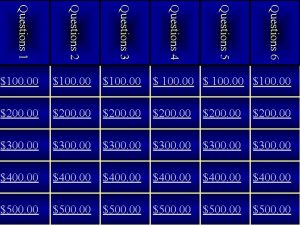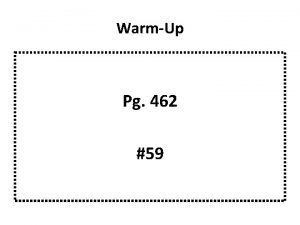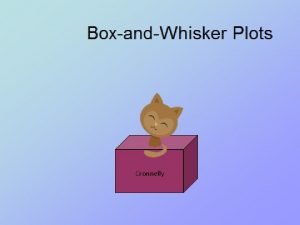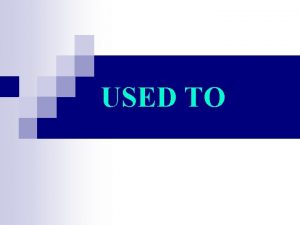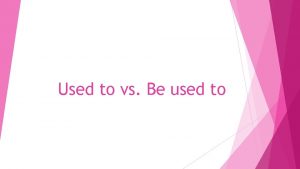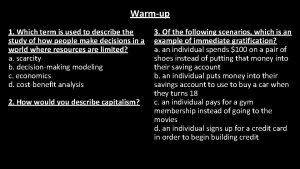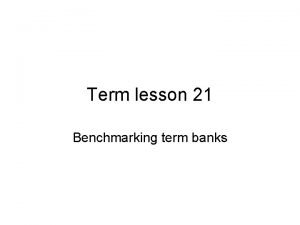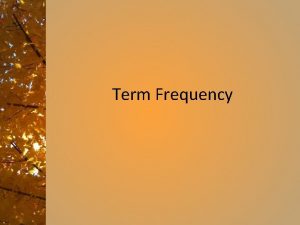Warmup Questions 1 What is the term used

















- Slides: 17

Warm-up Questions 1. What is the term used to refer to a ten year period? 2. What does AD stand for on a timeline?

Uncovering the Past UNDERSTANDING TIMELINES ANCIENT CIVILIZATIONS MR. HOLLINGSWORTH – 8 T H GRADE

Today’s Learning Targets I will be able to use the academic vocabulary of this region and time appropriately. I will be able to locate the seven continents and four oceans of the world on a map. I will identify the different terms and methods that are used to compartmentalize time. I will explain how historians and archaeologists study history to better understand the world today. I will describe the role that geography plays in the development of a civilization.

Warm-up Questions What is the term used to refer to a ten year period? ◦ decade What does AD stand for on a timeline? ◦ “In the year of our Lord”

Timelines Decade – 10 years Century – 100 years Age – a period of time marked by a single major cultural feature Era – a long period of time marked by great events, developments, or figures Circa or c. – a Latin phrase meaning about. Typically used when the exact timeframe is unknown B. C. – before Christ A. D. – (Anno Domini) … “in the year of our Lord. “ B. C. E. – Before common era C. E. – common era

Timelines can come in many different designs, but they all help to organize information in a chronological sequence so that it is easier to understand growth, change, recurring events, cause and effect, and key events of historical, social, and scientific significance. About how long ago did the first religious beliefs occur? ◦ 28, 000 B. C.

Timelines Which person was born first, Solomon or Confucius? ◦ Solomon

Timelines In which age did agriculture begin? ◦ Neolithic

11 5 3 1 9 4 8 2 10 6 7

Key Terms Review The study of the past… ◦ history A part or imprint of something that was once alive… ◦ fossil

Key Terms Review The study of the past based on what people left behind… ◦ archaeology An object created and used by humans… ◦ artifact

Key Terms Review Information gathered by someone who did not take part in or witness an event… ◦ secondary source The knowledge, beliefs, customs, and values of a group of people… ◦ culture

Key Terms Review An account of an event by someone who took part in or witnessed the event… ◦ primary source

Key Terms Review The study of the earth’s physical and cultural features… ◦ geography The natural features of the land’s surface… ◦ landforms

Key Terms Review The pattern of weather conditions in a certain area over a long period of time… ◦ climate All the living and nonliving things that affect life in an area… ◦ environment

Key Terms Review An area with one or more features that make it different from surrounding areas ◦ region Materials found in the earth that people need and value… ◦ resources

Today’s Learning Targets I can use the academic vocabulary of this region and time appropriately. I can locate the seven continents and four oceans of the world on a map. I can identify the different terms and methods that are used to compartmentalize time. I can explain how historians and archaeologists study history to better understand the world today. I can describe the role that geography plays in the development of a civilization.
 Warmup ratio
Warmup ratio Warmup 65
Warmup 65 Gmass warmup
Gmass warmup Stratified warmup
Stratified warmup Surface area warm up
Surface area warm up Mind rhyming words
Mind rhyming words Product of powers
Product of powers Java warmup
Java warmup Define:warmup
Define:warmup Ethos warmup
Ethos warmup Tinman warm up
Tinman warm up 65 mins
65 mins Warmup end
Warmup end Short medium and long term planning in education
Short medium and long term planning in education Term-to-term rule
Term-to-term rule Long term memory vs short term memory
Long term memory vs short term memory Quadratic sequence
Quadratic sequence Short term human resources examples
Short term human resources examples























